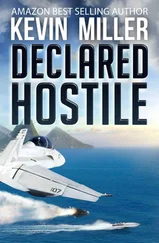The “Anbar Awakening” was a success story many Americans were aware of by late 2007, but Iraq was not a place where one political solution or one counter-insurgency model fit all provinces. Several pockets of resistance remained north and south along the Tigris River, and it was likely Wilson and his wingman would find evidence of one of those pockets on this flight.
* * *
They continued northwest and climbed above 30,000 feet in their transit of Kuwait. As they talked to air traffic controllers at various stations in Kuwait, in Iraq, or in AWACS aircraft, they noticed the occasional detached accent of a Brit ex-pat controller. Wilson selected his mission computer destination for Padres, the aerial refueling track. It was located southeast of Baghdad, 345 miles away from their present position, or about 50 minutes away. They were scheduled, or “fragged” to be on station 30 minutes later. Wilson set his fuel flow to burn 2,800 pounds per hour per engine and engaged the autopilot.
Below to his right, about 10 miles away, were the twin oil pipeline terminals Al Basrah and Khawr Al Amaya, thin angular man-made “islands” set on the blue Gulf and connected to Iraqi oilfields by underwater pipelines. Wilson observed one tanker at each terminal: a large, traditional, black-hulled crude carrier with white superstructure at one and another of similar design, but smaller and painted bright orange at the other. He locked up the larger vessel on the radar and slewed his infrared aiming diamond on it. The crude carrier showed up as a ghostly white image on his digital display, the wisps of its mooring lines visible on the infrared display because of the midday heat.
The two terminals dispensed the economic lifeblood of Iraq to eager customers from around the world. Wilson knew that SEAL teams lived on the platforms in austere conditions, and in triple-digit temperatures, to provide security. Off his left nose, he saw one of the strike group frigates, stationary in the water, but within close visual range of the platforms ready to serve as another layer of defense for the vital terminals. Further off his left side, and to the south, numerous oil platforms, some Saudi and others Kuwaiti, dotted the Gulf. He craned his neck to the right and behind in order to study Iran’s Kharg Island oil complex. Some 40 miles distant, the island had several bright flare stacks scattered about the sandy terrain. Nearby more tankers stood off from the island.
The nose of Wilson’s Hornet passed over Bubiyan Island, a large plug of barren land dividing the al-Faw Peninsula from the mainland of Kuwait. A small vessel was transiting up the Shatt-al-Arab waterway, the confluence of the Tigris and Euphrates rivers. This narrow ribbon of brown water, less than a half mile across, separated Iraq from Iran.
Wilson shot a glance at Smoke, flying in loose tac-wing formation, and in the distance saw the large metropolis of Kuwait City, with the distinctive Kuwait Towers dominating the northern shore. The city blocks were tightly packed into irregular geometric shapes that all converged on the north of the city and the Grand Mosque. Outside of the great city were only small scattered settlements.
Wilson’s daydreaming was interrupted by the radio hand-offs from controller to controller.
“ Nail four-one, contact Basra Control on Red one-five,” the controller said, using the call sign assigned by the Combined Air Operations Center, or CAOC, for this mission.
Wilson responded, “Roger, Nails switching Red one-five,” and in a command intended for Smoke, added, “Go button six.”
He punched in preset button six, waited several seconds, and then keyed the mike. “ Nail check.”
“Two,” Smoke replied.
Wilson then called the new controller. “Basra, Nail four-one flight with you enroute Padres at flight level three-five-zero.”
“ Nail four-one, Basra center. Radar contact, cleared direct Padres ,” answered the voice, which had a definitive Iraqi accent.
“ Nail four-one.”
Crossing into Iraq, Wilson noted the range to Exxon 55 , the aerial fueling tanker orbiting at Padres for their fragged mission give of 8,000 pounds. With over 300 miles to go at 435 knots ground speed, they had almost 45 minutes of cruising ahead of them.
Although he had flown through this narrow band of airspace between Kuwait and Iran dozens of times in his career, Wilson was once again struck by the landscape below. He scanned the desert floor of northern Kuwait both with his eyes and aircraft sensors for scars left over from Desert Storm some 17 years earlier. Scattered over the entire region, which was pockmarked with craters from coalition bombs, were long berms with irregular breeches that marked former Iraqi fighting positions and bunkers.
Wilson could only imagine the terror of the Iraqi boys who had lived for months on the cold, winter “moonscape,” as they faced the daily onslaught from above. Death came suddenly and with little warning through many means: iron bombs, LGBs, Rockeye , artillery, rockets, Mavericks, Hellfires , 20 or 30 millimeter, 105 millimeter. Mere movement in the open likely meant death, the stuff of their regular nightmares…
Outside on a cold, clear February night, three scared, hungry and chilled conscripts from Saddam City share a cigarette after relieving themselves. Enjoying the moon and stars and thinking of home, they are grateful to be out of that wretched bunker, ignoring their sergeant’s warning about lingering outside. The three soldiers watch the gunners to the east shoot their 57mm into the air and cheer them on to find a mark among the formations of invisible jets high above, the sound of which bathes the air in a low-frequency rumble. An American bomb flashes on the horizon, and they time the seconds until they hear the muffled Wump … 8 kilometers? 10?
Without warning, the guttural roar of a fighter pulling out of a dive rips through the air just above. Wordlessly and in unison, they bolt for the bunker like scared rabbits, wide-eyed with fear, not by conscious thought but by instinctive terror, knowing what it could mean. They saw us!
Exhorting each other to run for their lives, they hear an almost imperceptible “crack” over the noise of their boots and the rattle of their canteens under their winter coats. Gasping lungfuls of heavy desert air and searching for the bunker, they sprint wildly with gripping fear through the sand and the darkness toward the soft glow of light from the bunker entrance, hoping that they or their bunker are not targeted.
Only 30 meters to go! Keep pumping! Then a sound, a high-pitched whistle close above them, registers louder and louder in their brains, dozens then hundreds of whistles slowly melding into one terrifying shriek as the boys whimper for their mothers. A sparkling flash to the left, accompanied by a sharp POP , causes them to hunch over by reflex and as a second and third FLASH! POP! hit near them, they throw themselves headlong ( Mama! ) into the dirt as reality registers in their consciousness. C luster bombs! They claw at the land in a vain attempt to pull themselves into the sun-baked dirt as the whistling becomes a piercing din, and lethal bomblets pepper the ground all around them causing the earth to erupt in a deafening cacophony of horror and death.
And after the last fragment comes to rest, calm… as the low rumble of jet aircraft permeates the stillness of the now lifeless desert floor.
Wilson imagined what it must have been like for those kids almost 20 years ago.
Time and wind-driven sand had eroded the earthen fortifications and covered the vehicle hulks — and the bodies. Desert Storm — the “Mother of all Battles.” Wilson glanced at Smoke, where he should be in stepped up tac-wing, the same formation American fighters had been using to enter Iraqi airspace almost daily since the long ago winter of 1991. The battle was still not over, morphing, over time, into this routine Iraqi Freedom patrol.
Читать дальше












